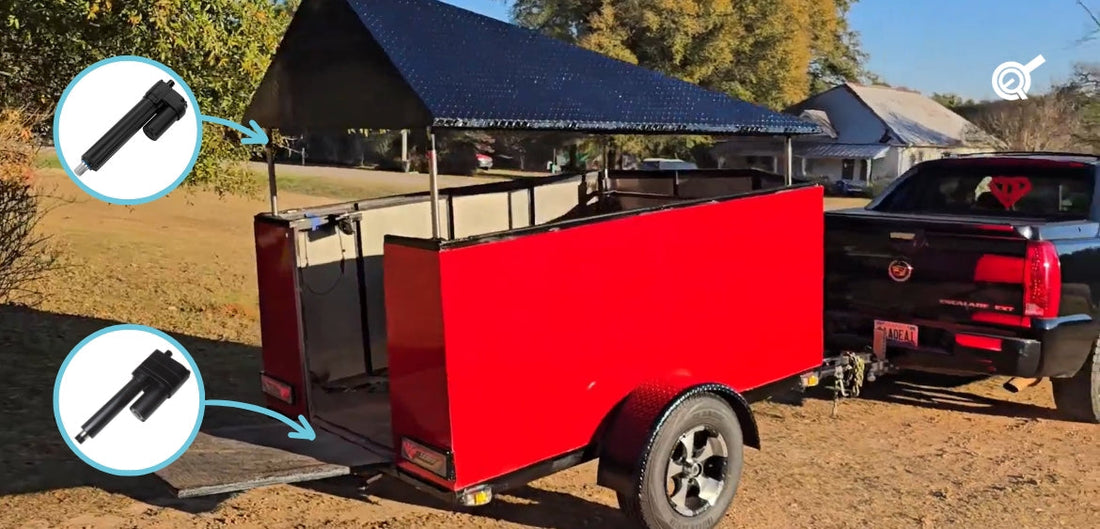Mobility limitations in a wheelchair can present challenges for individuals getting around town. David Padgett, a quadriplegic who uses a power wheelchair for daily mobility, needed a solution that was both functional and visually compelling. He set out to build a custom wheelchair trailer capable of securely transporting his chair while maintaining a compact height suitable for hospital parking garages. In this article, we will highlight his vision and how, with the help of Progressive Automations, he brought this unique and innovative wheelchair trailer project to life.
Inspiration Behind The Trailer

This project idea was driven by necessity as David’s wheelchair stands nearly 5 feet tall, but the trailer needed to stay under 7 feet to fit in most parking garages. A previous wheelchair trailer project he had overlooked this, leading to a complete redesign for a new one. The new concept involved 3-foot trailer sides with a 2-foot top that could lift for loading in a wheelchair and then lower to become watertight. An onboard ramp that can automatically deploy was also included as part of the new design plan.
Building Process & Challenges Encountered

Despite a C5-C6 spinal injury from a gunshot wound, David’s previous careers had given him welding experience that he still puts to use. With the help of friends Drew Middleton, Craig Hawsey, and his daughter Autumn Padgett, he sourced the necessary axle and steel and began fabrication of the trailer’s frame.
One of the early issues involved the steep incline created by the ramp, which made loading the wheelchair into the trailer difficult. To avoid lengthening the ramp or lowering the deck (for ground clearance), David devised a mechanism that tilts the trailer by 4” during loading to lessen the incline of the ramp. A winch with a wireless remote made pulling the wheelchair into place easy. By attaching the winch line to the chair’s front tie-down points and disengaging the motors, the chair could be smoothly drawn into the trailer.
To secure the wheelchair, retractable straps were attached to welded tie-down blocks at the rear of the trailer. Once the chair cleared the ramp, the straps were hooked to the rear of the chair and pulled tight by the winch. All at once, the trailer would untilt, the ramp would raise, and the top would lower using actuators as the drive system.
Finding the Right Suppliers For Actuators

David had previously tried using 3rd party electric linear actuators, however, they were loud, slow, and continuously had failures after 40 to 50 days of use, which falls outside their 30-day warranty period. Seeking a better solution after his 3rd set of linear actuators failed in a 5-month period, he stumbled into Progressive Automations after doing some online research. He found our actuators were quieter, faster, and significantly more durable with an 18 month warranty.
After reading some reviews and speaking to a representative, he decided to give our products a try. He found the price was reasonable, and after receiving and installing the linear actuators, David was impressed with the quality. Our linear actuators were quieter, had no problem handling the weight, and David found our linear actuators at least 3 times faster than his previous actuators. Our linear actuators he had previously acquired, were still working well after four years of service, so when the time came to order actuators, David knew Progressive Automations would be his next choice.
Addressing Design Flaws

The ramp on the rear was previously raised and lowered with an old wheelchair motor and wheel hub attached to a cable and pulley system. It was controlled with a remote relay and had limit switches in place to stop the movement of the ramp. The wiring was complicated, and because of the high amperage draw of the wheelchair motor, limit switches and diodes kept burning out. To solve this design flaw, David switched to using electric actuators to control the movement of the ramp.
The linear actuator would have interfered with the loading of the wheelchair if mounted inside, so David decided to mount it underneath the trailer. With the ramp being hinged 3" above the frame of the trailer and the weight of the ramp, an actuator couldn't just be attach to the base. After doing some geometry homework, David decided the attachment point needed to be 4" above the bottom of the ramp, extend out 3" from the ramp, and drop down 7" to the mounting bracket for the actuators. After welding and testing the setup with old actuators, the system worked great.
Sponsorship and Actuator Setup

For the latest trailer project, David initially used four standard aluminum actuators (two 24-inch stroke and two 12-inch stroke), but found they couldn’t safely support the top frame without hinges. The solution required heavy-duty actuators with stainless steel shafts—an unplanned expense that nearly halted the project. Fortunately, David found and applied for the Progressive Automations sponsorship program. Our team got in touch and agreed to sponsor the following heavy-duty actuators:
- 2x PA-HD1-24-450-N-12VDC (24 inch, 450 lbs force)
- 2x PA-HD1-12-900-N-12VDC (12 inch, 900 lbs force)
- 1x PA-17-4-2000-POT (4 inch, 2000 lbs force)
- 1x PA-17-14-850 (14 inch, 850 lbs force)
The PA-HD1 actuators powered the trailer top and ramp, while the PA-17 actuators were used for additional automation features. Our BRK-17 mounting brackets were used where possible, and custom mounts were fabricated to fit the confined spaces. The linear actuators were carefully selected with different stroke lengths and force ratings so they could perform different functions while still completing their cycles at about the same time.
Control and Power Systems
The linear actuators were controlled using a high-amp reverse solenoid relay paired with a wireless reverse remote relay, allowing full operation from a single push-button remote. The power came from David’s truck, equipped with dual high-output alternators and batteries to power a 13,000-watt stereo system. A 4-gauge OFC (Oxygen-Free Copper) wire ran from the second battery to the back of the truck and was terminated with a disconnect plug. The same plugged wire on the trailer side was connected to the electric actuators and winch to ensure they were supplied with plenty of power.
The Story Behind the Project’s Inspiration

After completing the wiring, David began cutting and bending the outside aluminum trailer skin (smooth on the bottom and diamond plate on the top). He didn't want a lot of rivets or screw heads visible, so the aluminum panels were attached to the frame with double-sided VHB tape, made for trailer skin. It holds so well that if you tried to remove it, you would rip the aluminum before you pulled it away from the frame.
The final step was to make the trailer visually appealing. Initially, the top was painted, and the bottom was covered with vinyl wrap. The original exterior included a vinyl wrap, but it failed during highway driving. It was replaced with acid etch primer and paint for the entire trailer: candy apple red for the bottom and jet black for the top, finished with a glossy clear coat. The final product was both rugged and eye-catching.
Modular Design and Future Possibilities

Small, cheaply made wheelchair trailers cost over $5000, while this trailer with upgraded actuators only has $3500 - $3900 worth of materials in it. David’s intentions are to try and build for whoever needs one and for just the cost of materials, as he knows firsthand how expensive being wheelchair bound can be. Although designed for a wheelchair, the trailer's concept could be easily modified to transport motorcycles, ATVs, or other equipment. Currently, David is exploring the idea of launching a business that manufactures these custom adaptive trailers to help others benefit from his innovative creation and give back to the disabled community.
IN SUMMARY
This project goes beyond functionality—it embodies perseverance, creativity, and the spirit of collaboration. Progressive Automations is proud to play a part by supplying high-quality components and supporting the vision as a sponsor.
Thank you, David Padgett, for sharing your project with us! Check out his Facebook page to keep up with his latest updates!
For anyone working on custom wheelchair trailer projects, we hope you found this article about David’s wheelchair trailer as inspiring as we did! If you're exploring heavy duty linear actuator solutions for your next automation project or wish to discuss our products further, please feel free to reach out to us! We are experts in what we do and will be happy to assist however we can.
sales@progressiveautomations.com | 1-800-676-6123




